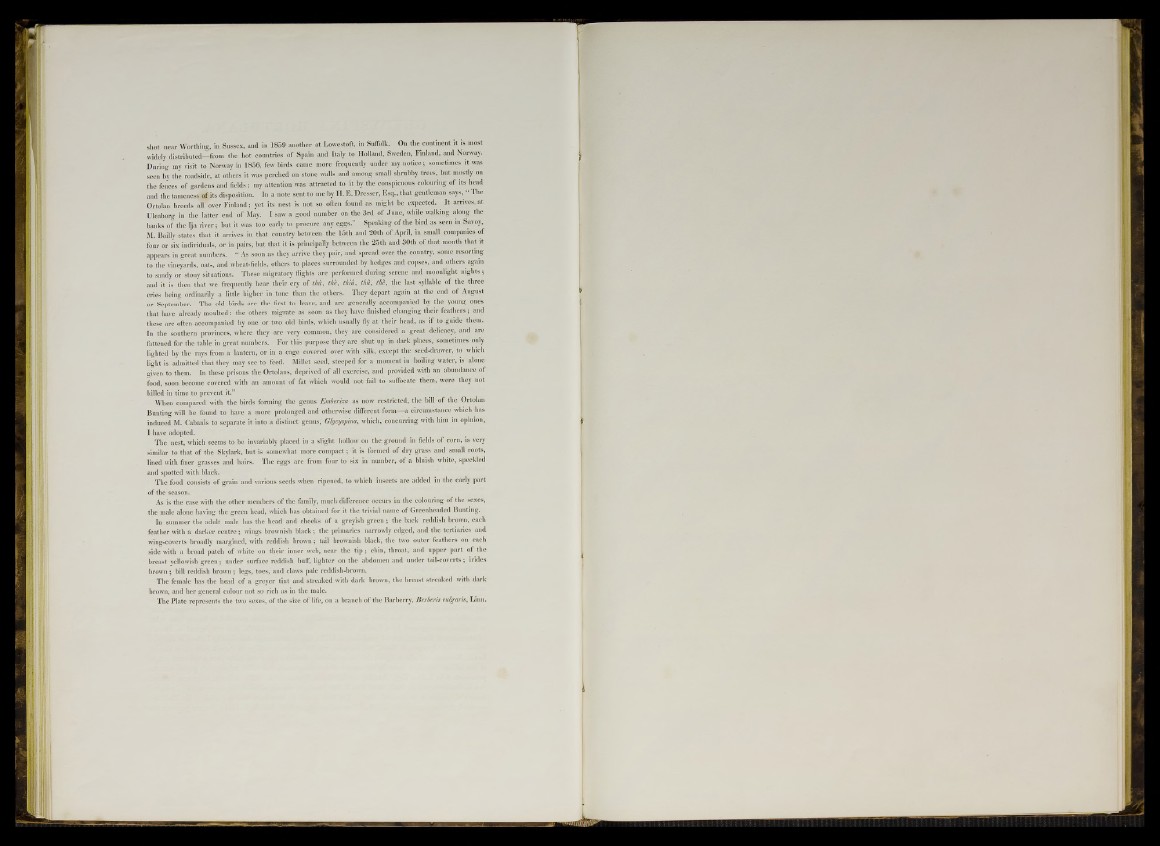
shot near Worthing, in Sussex, and in 1859 another at Lowestoft, in Suffolk. On the continent it is most
widely distributed—from the hot countries of Spain and Italy to Holland, Sweden, Finland, and Norway.
During my visit to Norway in 1856, few birds came more frequently under my notice ; sometimes it was
seen by the roadside, at others it was perched on stone walls and among small shrubby trees, but mostly on
the fences of gardeus and fields : my attention was attracted to it by the conspicuous colouring of its head
and the tainenesstof its disposition. In a note sent to me by H. E. Dresser, Esq., that gentleman says, “ The
Ortolan breeds ail over Finland; yet its nest is not so often found as might he expected. It arrives, at
Uleaborg in the latter end of May. I saw a good number on the 3rd of June, while walking along the
banks of the Ija river ; but it was too early to procure any eggs." Speaking of the bird as seen in Savoy,
M. Baiily states that it arrives in that country between the 15th and 20th of April, in small companies of
four or six individuals, or in pairs, but that it is principally between the 25tll and 30th of that month that it
appears in great numbers. ■■ As soon as they arrive they pair, and spread over the country, some resorting
to the vineyards, oat-, and wheat-fields, others to places surrounded by hedges and copses, and others again
to sandy or stony situations. These migratory flights are performed during serene and moonlight nights ;
and it is then that we frequently hear their cry of thù, thè, thiu, thu, thè, the last syllable of the three
cries being ordinarily a little higher in tone than the others. They depart again at the end of August
or September. The old birds are the first to leave, and ire generally accompanied by the ydnng ones
that have already moulted : the others migrate as soon as they have finished changing their feathers ; ind
these are often accompanied by one or two old birds, which usually fly at their head, as if to guide them.
In the southern provinces, where they are very common, they are considered a great delicacy, and are
fattened for the table in great numbers. For this purpose they are shut up in dark places, sometimes only-
lighted by the rays from a lantern, or in a cage covered over with silk, except the seed-drawer, to which
light is admitted that they may see to feed. Millet seed, steeped for a moment in boiling water, is alone
given to them. In these prisons the Ortolans, deprived of all exercise, and provided with an abundance of
food, soon become covered with an amount of fat which would not fail to suffocate them, were they not
killed in time to prevent it.”
When compared with the birds forming the genus Emberiza as now restricted, the bill o f the Ortolan
Bunting will be found to have a more prolonged and otherwise different form—a circumstance which has
induced M. Cabanis to separate it into a distinct genus, Glycyspina, which, concurring with him in opinion,
I have adopted.
The nest, which seems to be invariably placed iu a slight hollow on the ground in fields of corn, is very
similar to that of the Skylark, but is somewhat more compact ; it is formed of dry grass and small roots,
lined with finer grasses and hairs. The eggs are from four to six in number, of a bluish white, speckled
and spotted with black.
The food consists of grain and various seeds when ripened, to which insects are added in the early part
of the season.
As is the case with the other members of the family, much difference occurs in the colouring of the sexes,
the male alone having the green head, which has obtained for it the trivial name of Greenheaded Bunting.
In summer the adult male has the head and cheeks of a greyish green ; the back reddish brown, each
feather with a darker centre ; wings brownish black ; the primaries narrowly edged, and the tertiaries and
wing-coverts broadly margined, with reddish brown ; tail brownish black, the two outer feathers on each
side with a broad patch of white on their inner web, near the tip ; chin, throat, and upper part of the
breast yellowish green ; under surface reddish buff, lighter on the abdomen and under tail-coverts ; irides
brown ; bill reddish brown ; legs, toes, and claws pale reddish-brown.
The female has the head of a greyer tint and streaked with dark brown, the breast streaked with dark
brown, and her general colour not so rich as in the male.
The Plate represents the two sexes, of the size of life, on a branch of the Barberry, Berberis vulgaris, Linn.